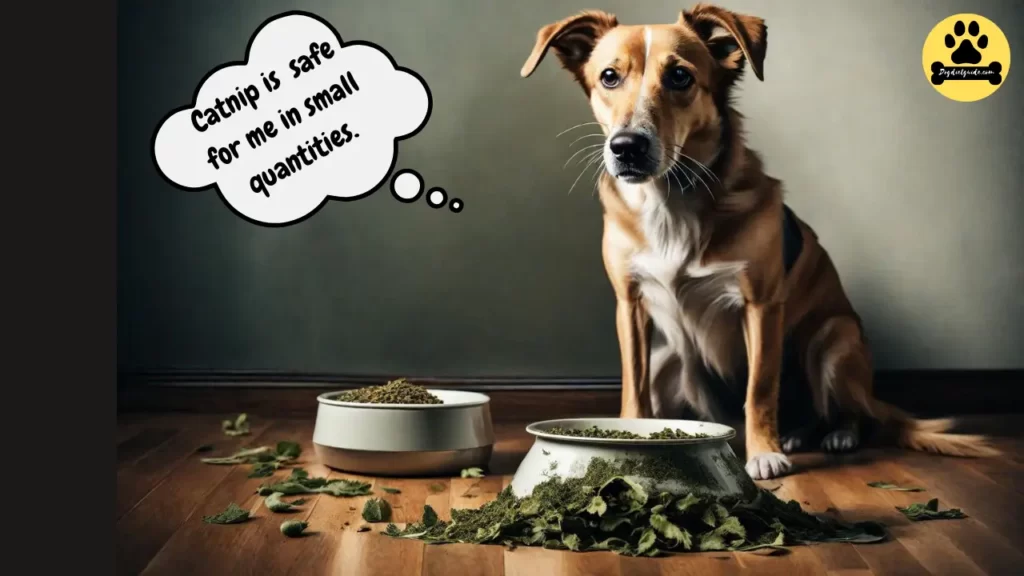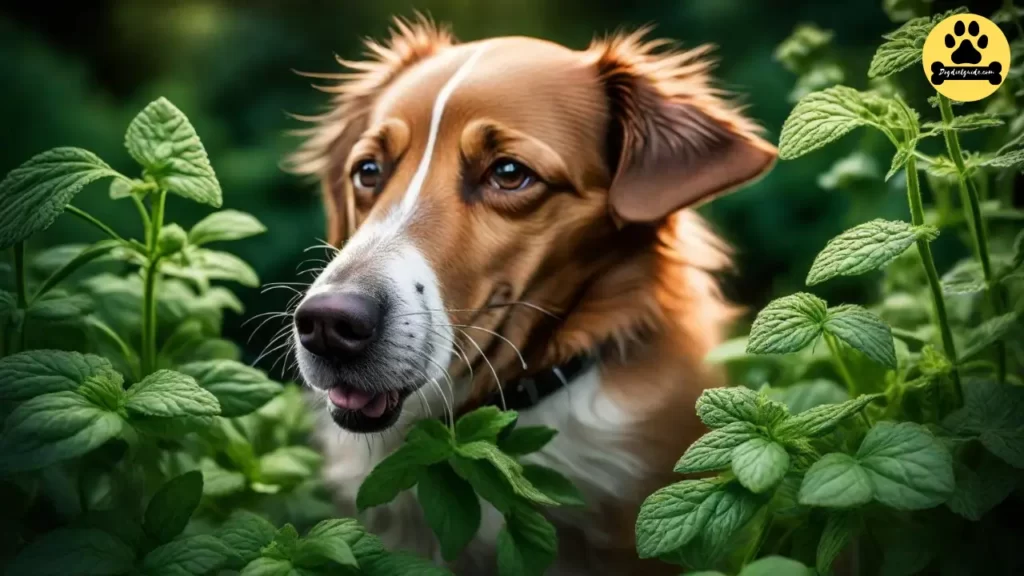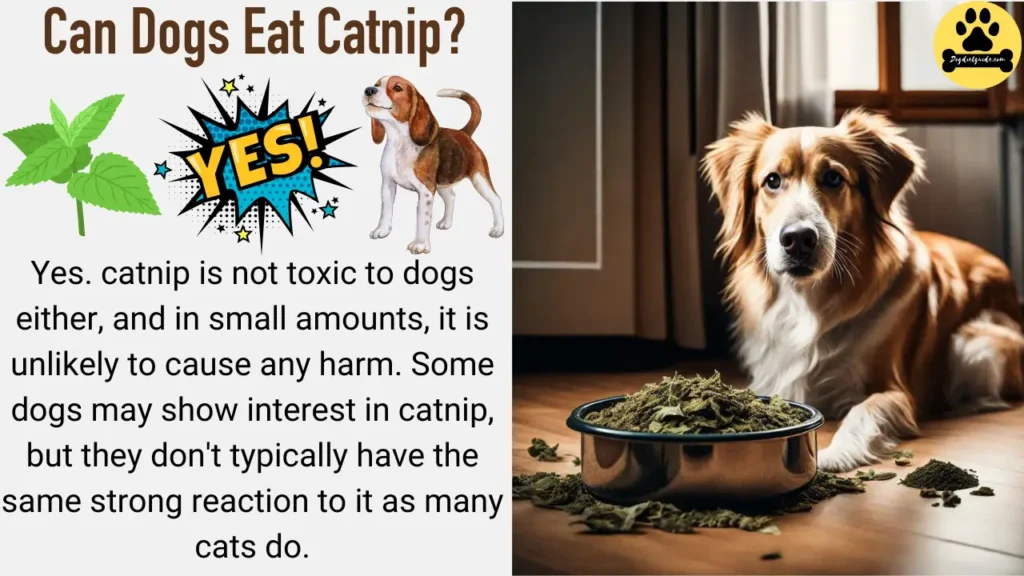In the fascinating world of pet ownership, the boundaries between what our furry friends can and cannot indulge in often blur. Whether dogs can partake in the pleasures of catnip, a herb renowned for its intoxicating effects on felines, piques the curiosity of many pet enthusiasts. So, can dogs eat Catnip?
As pet owners, we strive to provide our canine companions with the best care possible, and understanding the potential impact of catnip on dogs becomes crucial.
Overview
Catnip is considered safe for dogs in small quantities. Research conducted by Tina Wismer, DVM, MS, DABVT, the director of the ASPCA, concluded that both fresh and dried versions of catnip are considered safe for dogs and have medicinal effects on canines. However, it’s important to note that different canines may react differently to catnip.
Understanding Catnip: A Feline’s Delight
Catnip, scientifically known as Nepeta cataria, is an herb renowned for its euphoric effects on cats. Native to Europe and Asia, this member of the mint family contains a compound called nepetalactone, responsible for triggering the characteristic feline response.
Can Dog Eat Catnip?
Yes. catnip is not toxic to dogs either, and in small amounts, it is unlikely to cause any harm. Some dogs may show interest in catnip, but they don’t typically have the same strong reaction to it as many cats do.
If your dog happens to ingest a small amount of catnip, it is likely to be safe. However, as with any new substance, it’s a good idea to monitor your dog for any adverse reactions.
If your dog ingests a large amount of catnip, it could potentially cause some gastrointestinal upset, but the risk of serious toxicity is generally low.

What Does Catnip Do To Dogs?
Catnip typically strongly affects cats, eliciting behaviors ranging from rolling and rubbing to hyperactivity and playfulness. However, catnip is not known to have a significant impact on dogs. Canines generally do not respond to catnip in the same way that cats do.
Following are some of the effects of catnip on dogs:
-
Mild Sedative Effect: Some dogs may experience a mild calming effect when exposed to catnip. Not all canines react in the same way; individual reactions can vary.
-
Mood Enhancement: Catnip may have a mild mood-enhancing effect on some dogs, similar to its effects on cats. Mild mood-enhancing occurs due to the compound nepetalactone, which interacts with receptors in the nasal tissue.
-
Repellent Properties: Catnip contains nepetalactone, which has been reported to act as a natural insect repellent. While this might be beneficial, it’s important to note that the effects are likely minimal compared to specialized dog-safe repellents.
-
Digestive Aid: In some cases, catnip has been suggested to have digestive benefits for dogs. It may help alleviate mild digestive issues, such as gas or indigestion, although scientific evidence supporting this is limited.
-
Environmental Enrichment: Even though furry friends may not react to catnip the same way as cats, some dogs might find the scent of catnip exciting or engaging. Introducing new smells and textures to a dog’s environment can contribute to mental stimulation.

Catnip For Dogs Anxiety
Can you give catnip to dogs for anxiety? Catnip has calming and mood-enhancing properties for dogs. In moderation, you can use catnip to alleviate anxiety in your furry friend.
Give catnip to your pooch about 30 minutes before encountering anxious situations, such as leaving for grooming, traveling, or experiencing fireworks, etc.
How Much Catnip For Dogs?
To alleviate anxiety in your dogs, adding about ¼ tsp to their food is an easy and effective way to enhance your canine’s mood.
-
Puppies (Up to 6 months):
-
Dosage: Start with a small amount, around 1/8 teaspoon, and monitor your puppy’s reaction. Puppies may be more sensitive, so it’s crucial to introduce any new substance cautiously.
-
-
Adult Dogs (6 months to 7 years):
-
Dosage: Approximately 1/4 to 1/2 teaspoon of dried catnip can be sprinkled on their food. Again, start with a smaller amount and observe your pet’s behavior.
-
-
Senior Dogs (7 years and older):
-
Dosage: Like adult dogs, around 1/4 to 1/2 teaspoon is a good starting point. However, consider any pre-existing health conditions or medications your senior dog may be on and consult your vet for tailored advice.
-
Related Post: Can Dogs Eat Farro?
How Long Does Catnip Last On Dogs?
The effect of catnip in dogs can range from a few minutes to around 15-30 minutes, similar to the timeframe observed in cats. During this time, a dog may exhibit behaviors such as sniffing, rubbing, rolling, or playing with catnip-infused toys.

Catnip Benefits For Dogs
-
Catnip contains nepetalactone, which may have a mild calming effect on dogs, helping to alleviate anxiety or hyperactivity.
-
Catnip has anti-inflammatory properties that could benefit dogs with mild inflammatory conditions.
-
The pleasant scent of catnip can serve as a natural aromatherapy option, creating a calming environment for dogs.
-
In some cases, catnip may assist with minor digestive issues in dogs.
Catnip Risks For Dogs
-
Ingesting large amounts may lead to vomiting or diarrhea. Introduce gradually and in small quantities.
-
Some dogs may be allergic, showing itching, redness, swelling, or hives. Discontinue use if allergic reactions occur.
-
Dogs may become overly excited. Monitor reactions, especially in dogs prone to hyperactivity.
-
Some dogs may show little to no interest in catnip, and that’s normal.
-
Be cautious with catnip products that may contain additives or chemicals. Stick to natural, pure catnip.
-
Avoid catnip, as it could potentially stimulate uterine contractions. Consult a veterinarian before introducing new herbs or supplements, especially during pregnancy.

Related Post: What to Do When Dog Eat Spicy Food?
How to Give Catnip to Dogs Safely.
-
Choose High-Quality Catnip: Option for high-quality, natural catnip without additives or chemicals. Look for catnip products that are specifically labeled as safe for dogs.
-
Introduce Gradually: Start with a small amount of catnip to gauge your pup’s reaction. This can be especially important for dogs that have not been exposed to catnip before.
-
Observe Your Dog’s Reaction: Watch your furry friend closely for any signs of discomfort, allergic reactions, or overstimulation. If your dog has adverse effects, discontinue use and consult your veterinarian.
-
Avoid Overconsumption: While catnip is generally safe, excessive consumption can lead to gastrointestinal upset. Use catnip in moderation to prevent any adverse effects.
-
Monitor Allergic Reactions: Look for signs of allergies, such as itching, redness, or swelling. Stop using catnip and consult your veterinarian if you notice any allergic reactions.
-
Avoid During Pregnancy: If your dog is pregnant, it’s advisable to avoid giving her catnip, as it may stimulate uterine contractions.
-
Consult with Your Veterinarian: If your canine has any concerns or has pre-existing health conditions, consult with your veterinarian before introducing catnip.
Catnip Equivalent For Dogs
Anise is considered equivalent to catnip for dogs. It’s important to note that canines can react differently to herbs, and individual preferences may differ. Anise (Pimpinella anisum) is an herb that has a licorice-like scent and flavor.
Here’s some information about anise as a potential catnip equivalent for dogs:
Anise for Dogs:
-
Aromatic Appeal: Anise has a strong, sweet aroma that some canines find appealing. The scent may attract and interest them, similar to how catnip can captivate cats.
-
Calming Properties: Similar to catnip, some pup owners believe anise has mild soothing properties to help manage and relax dogs. This may be particularly useful in situations where puppies experience anxiety or stress.
-
Safe Consumption: Anise is generally considered safe for puppies in moderation. However, as with any new herb or treat, starting with small amounts is crucial to observe your dog’s reaction and ensure no adverse effects.
Ways to Introduce Anise:
-
Anise Seeds: You can offer your dog small amounts of anise seeds. Crushing the seeds slightly before submitting them may enhance the release of aroma.
-
Anise Tea: Some pet owners add mild anise tea to water or food. Make sure the tea is cooled adequately before offering it to your dog.
The Allure of Catnip for Cats
When cats come into contact with catnip, whether by sniffing, licking, or rolling in it, nepetalactone binds to receptors in their nasal tissue, leading to behaviors ranging from playfulness to relaxation.
Can Dogs Get High on Catnip?
While catnip holds a special place in the feline world, its effects on dogs differ significantly. Unlike cats, most dogs don’t react strongly to catnip.
The nepetalactone that entices cats doesn’t produce the same euphoria in our canine companions. Thus, dogs won’t get “high” on catnip like their feline counterparts.
Can Dogs Eat Catnip Treats?
Yes, in moderation, dogs can eat catnip treats, as long as the treats do not contain excessive catnip. The recommended amount of catnip for dog treats is 1/4 teaspoon.
Final Thoughts: Can Dogs Eat Catnip?
In conclusion, yes, dogs can eat catnip with caution. While catnip is a staple for feline fun, its allure doesn’t extend as strongly to dogs. While safe in moderation, paying attention to your dog’s reactions and exploring other herbs and toys that align better with their preferences is essential.










![Can Dogs Eat Blood? 7 Side Effects [Expert Opinion]](https://petskor.com/wp-content/uploads/2022/04/Webp.net-resizeimage-12.jpg)
